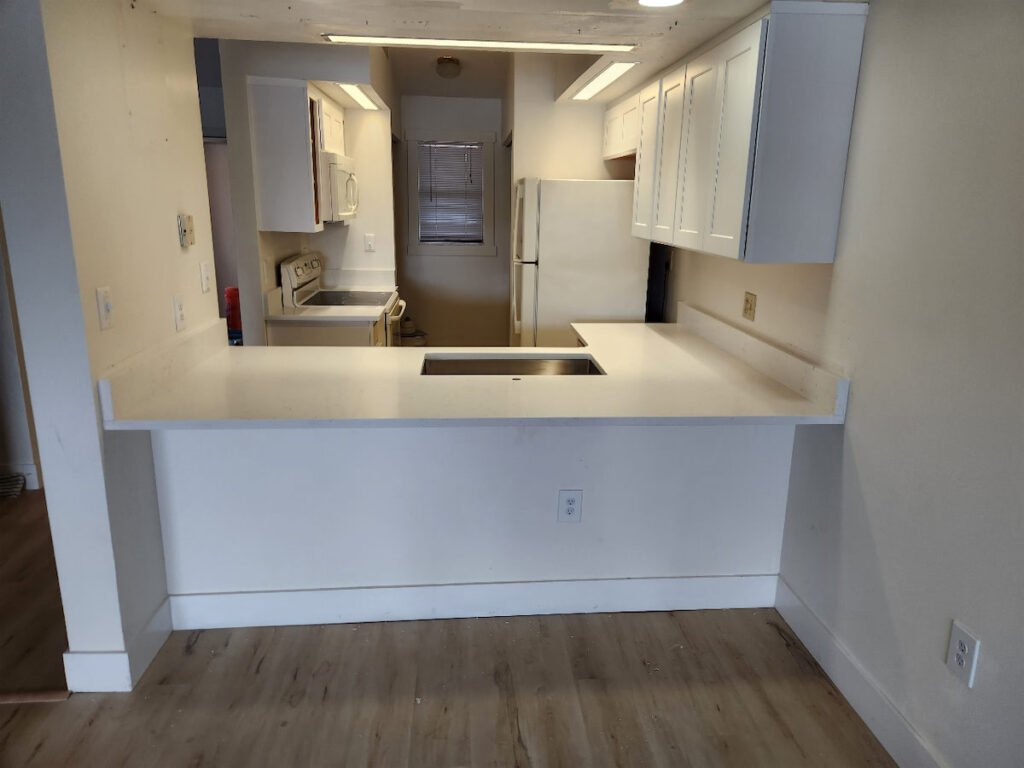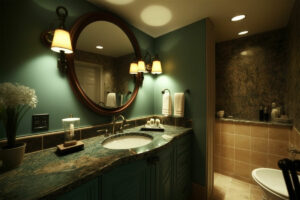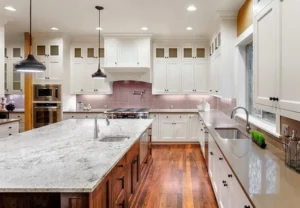The kitchen has evolved from a purely functional space into the heart of the home, where design and practicality converge. Modern kitchens are a reflection of the latest trends in interior design, blending aesthetics, technology, and functionality. Innovative kitchen designs are characterized by their open layouts, seamless integration of appliances, creative storage solutions, and use of sustainable materials. These designs not only enhance the cooking experience but also create a welcoming environment for family gatherings and entertaining guests.
Custom stone countertops play a crucial role in innovative kitchen designs, offering both beauty and functionality. Stone countertops, such as granite, marble, quartz, and soapstone, are prized for their durability, natural beauty, and unique patterns. They provide a high-end, luxurious look that can elevate the overall design of the kitchen. Additionally, custom stone countertops can be tailored to fit any kitchen layout, ensuring a perfect fit and a cohesive design. They are also resistant to heat, scratches, and stains, making them a practical choice for busy kitchens. By choosing custom stone countertops, homeowners can enjoy a timeless, elegant surface that enhances their kitchen’s style and functionality.
The Evolution of Kitchen Design
Historical Perspectives
The design and functionality of kitchens have undergone significant changes over the centuries, reflecting broader shifts in technology, culture, and domestic life.
- Ancient Kitchens: In ancient times, kitchens were basic and functional spaces primarily used for cooking and food storage. The hearth was the central element, used for both heating and cooking. Early kitchens lacked ventilation, making them smoky and uncomfortable.
- Medieval Kitchens: During the medieval period, kitchens remained utilitarian but became more structured, often located in separate buildings to prevent fires in the main house. Large fireplaces with spits for roasting and open flames for cooking were common.
- Renaissance to the 18th Century: Kitchens started to move indoors, especially in affluent homes. The introduction of chimneys improved ventilation. The development of cast iron stoves in the 18th century marked a significant technological advancement, offering better control over cooking temperatures.
- 19th Century: The Industrial Revolution brought significant changes, including the mass production of kitchen appliances. The Victorian kitchen was characterized by its practicality, with a focus on cleanliness and efficiency. Gas stoves and iceboxes became common, making cooking and food storage more convenient.
- Early 20th Century: The early 20th century saw the rise of the “domestic science” movement, emphasizing efficiency and hygiene in kitchen design. The L-shaped and U-shaped kitchen layouts were developed to optimize workflow. The advent of electricity led to the introduction of electric appliances, further transforming the kitchen into a more functional space.
Modern Trends in Kitchen Design
Contemporary kitchen design is a dynamic field, driven by advancements in technology, changing lifestyles, and an increasing emphasis on sustainability and aesthetics.
- Open Concept Layouts: Modern kitchens often feature open floor plans that integrate the kitchen with dining and living areas, creating a more social and interactive space. This design promotes a seamless flow and enhances the sense of spaciousness.
- Minimalist and Sleek Designs: Clean lines, minimalistic aesthetics, and a focus on simplicity are hallmarks of modern kitchen design. Built-in appliances, handleless cabinets, and hidden storage solutions contribute to a streamlined look.
- Smart Kitchens: Technology plays a significant role in contemporary kitchen design. Smart appliances, such as refrigerators, ovens, and dishwashers, can be controlled via smartphones or voice commands. Innovations like touchless faucets and automated lighting enhance convenience and efficiency.
- Sustainable Materials: There is a growing emphasis on using eco-friendly materials and practices in kitchen design. Recycled materials, energy-efficient appliances, and sustainable countertop options, such as recycled glass or composite stone, are increasingly popular.
- Customization and Personalization: Modern kitchens are often customized to reflect the homeowner’s preferences and lifestyle. This includes personalized cabinetry, unique countertop materials, and bespoke storage solutions.
- Multifunctional Spaces: The kitchen is no longer just a place for cooking. Modern designs often incorporate features like breakfast bars, coffee stations, and workspaces, making the kitchen a versatile hub for various activities.
The evolution of kitchen design highlights the continuous adaptation of this essential space to meet the needs and preferences of each era. Today, innovative kitchen designs combine functionality, aesthetics, and technology to create environments that enhance the culinary experience and the overall quality of life.
Types of Custom Stone Countertops
Granite Countertops
Granite countertops are a popular choice for many homeowners due to their durability and timeless appeal. Granite is a natural stone that comes in a variety of colors and patterns, making each countertop unique.
- Durability: Granite is one of the hardest natural stones, making it highly resistant to scratches and heat.
- Aesthetic Appeal: Its natural beauty and wide range of colors and patterns can complement any kitchen design.
- Maintenance: Requires sealing to prevent staining, but with proper care, it can last a lifetime.
- Cost: Typically mid-to-high range in price, but considered a worthwhile investment due to its longevity.
Marble Countertops
Marble countertops exude elegance and luxury, often associated with high-end kitchen designs. This natural stone is known for its striking veining and classic look.
- Aesthetic Appeal: Marble offers a sophisticated and timeless look, with unique veining patterns that add character.
- Softness: While visually stunning, marble is softer than granite and can scratch or etch more easily.
- Maintenance: Requires regular sealing and careful cleaning to prevent staining and damage.
- Cost: Generally more expensive than granite, reflecting its high-end appeal and maintenance requirements.
Quartz Countertops
Quartz countertops, also known as engineered stone countertops, are made from crushed quartz mixed with resin. They offer a durable and low-maintenance alternative to natural stone.
- Durability: Highly resistant to scratches, stains, and heat, making them ideal for busy kitchens.
- Consistency: Available in a wide range of colors and patterns, providing a uniform look that natural stones may not offer.
- Maintenance: Non-porous surface that does not require sealing and is easy to clean.
- Cost: Mid-to-high range, depending on the quality and brand.
Soapstone Countertops
Soapstone is a natural stone with a soft, smooth feel and a rustic charm. It is often chosen for its unique aesthetic and durability.
- Durability: Resistant to heat and stains, though it can develop a patina over time that adds to its character.
- Aesthetic Appeal: Offers a softer, matte finish with subtle veining, typically in shades of gray.
- Maintenance: Does not require sealing, but regular oiling can enhance its appearance and patina development.
- Cost: Comparable to granite, with the added benefit of low maintenance.
Other Exotic Stones
For those seeking a truly unique kitchen design, exotic stones such as onyx, travertine, and limestone offer distinct aesthetics and luxurious appeal.
- Onyx Countertops: Known for their translucent properties and striking patterns, onyx adds a dramatic focal point to any kitchen. It is, however, softer and more prone to scratches and stains.
- Travertine Countertops: A form of limestone, travertine has a textured, porous surface with natural pitting. It provides a warm, rustic look but requires sealing and maintenance to prevent staining.
- Limestone Countertops: Offers a soft, natural look with subtle patterns and colors. Like marble, limestone is softer and requires careful maintenance to avoid damage.
Each type of custom stone countertop brings its own set of benefits and considerations. By understanding the unique characteristics of each material, homeowners can make informed decisions that align with their design preferences, lifestyle, and budget.
Benefits of Custom Stone Countertops
Durability and Longevity
One of the most significant advantages of custom stone countertops is their exceptional durability and longevity.
- Hardness: Materials like granite and quartz are among the hardest natural stones, making them resistant to scratches, chips, and other forms of wear and tear.
- Heat Resistance: Stone countertops can withstand high temperatures, allowing homeowners to place hot pots and pans directly on the surface without causing damage.
- Stain Resistance: Many stone countertops, especially those made from quartz, are non-porous and highly resistant to stains from common kitchen substances like wine, coffee, and oils.
- Longevity: With proper care and maintenance, stone countertops can last a lifetime, making them a long-term investment for any home.
Aesthetic Appeal
Custom stone countertops are renowned for their natural beauty and unique visual appeal.
- Natural Patterns: Each slab of natural stone is unique, featuring one-of-a-kind patterns, veining, and color variations that add character and elegance to any kitchen.
- Variety of Colors: Stone countertops come in a wide range of colors and finishes, from the deep, rich tones of granite to the light, airy hues of marble, allowing for versatile design options.
- Luxurious Look: The natural beauty and high-end appearance of stone countertops can elevate the overall aesthetic of the kitchen, creating a sophisticated and inviting space.
Value Addition to Property
Installing custom stone countertops can significantly enhance the value of a property.
- Market Appeal: Kitchens with stone countertops are often seen as desirable features in real estate listings, attracting potential buyers and increasing the marketability of the home.
- Return on Investment: While the initial cost of stone countertops may be higher than other materials, their durability and timeless appeal often result in a high return on investment when it comes time to sell the property.
- Perceived Quality: Custom stone countertops are associated with high-quality construction and design, contributing to the overall perception of a well-maintained and luxurious home.
Customization Options
Custom stone countertops offer a wide range of customization options, allowing homeowners to create a kitchen that perfectly suits their needs and style.
- Tailored Fit: Stone countertops can be cut and fabricated to fit any kitchen layout, including custom shapes, edge profiles, and unique design elements.
- Personalized Design: Homeowners can choose from a variety of stone types, colors, and finishes to match their personal taste and the overall design theme of their kitchen.
- Integrated Features: Custom stone countertops can incorporate special features such as built-in sinks, integrated drainboards, and seamless backsplashes, enhancing both functionality and aesthetics.
The benefits of custom stone countertops extend beyond their stunning appearance. Their durability, ability to add value to a property, and extensive customization options make them a worthwhile investment for any kitchen renovation or new build.
Innovative Design Ideas
Open Concept Kitchens
Open concept kitchens have become a hallmark of modern home design, breaking down barriers between the kitchen, dining, and living areas to create a unified, spacious environment.
- Seamless Flow: By eliminating walls and partitions, open concept kitchens facilitate better flow and communication between different areas of the home, making it easier for families and guests to interact.
- Natural Light: This design allows natural light to penetrate further into the home, creating a brighter and more inviting space.
- Versatile Spaces: Open layouts offer greater flexibility in furniture placement and can be adapted to suit various activities, from cooking and dining to entertaining and relaxing.
- Visual Continuity: Consistent design elements and materials can be used throughout the open space to create a cohesive and harmonious look.
Multi-functional Islands
Kitchen islands have evolved from simple countertop extensions to versatile, multi-functional centers of activity.
- Additional Work Surface: Islands provide extra counter space for food preparation, cooking, and baking, making kitchen tasks more efficient.
- Storage Solutions: Incorporating cabinets, drawers, and shelves into the island offers valuable storage for kitchen essentials, cookware, and small appliances.
- Seating Area: Adding bar stools or chairs transforms the island into a casual dining or breakfast area, perfect for quick meals and socializing.
- Integrated Appliances: Many islands now feature built-in appliances such as cooktops, ovens, microwaves, and wine coolers, centralizing kitchen functions and freeing up other areas of the kitchen.
Integrated Appliances
The trend of integrating appliances into kitchen cabinetry and countertops creates a sleek, uncluttered look that enhances both aesthetics and functionality.
- Concealed Refrigerators: Built-in refrigerators and freezers are designed to blend seamlessly with cabinetry, maintaining a clean and uniform appearance.
- Hidden Dishwashers: Panel-ready dishwashers can be disguised behind cabinetry panels, making them virtually invisible and contributing to a streamlined design.
- Microwave Drawers: Placing microwaves in lower cabinets or drawers keeps them out of sight while maintaining easy access, preserving counter space.
- Pop-up Outlets and Charging Stations: Discreetly integrated electrical outlets and charging stations ensure that the kitchen remains functional without detracting from the overall design.
Creative Storage Solutions
Effective storage solutions are crucial for maintaining an organized and clutter-free kitchen. Innovative designs offer practical and aesthetically pleasing options.
- Pull-out Shelves and Drawers: Deep cabinets can be equipped with pull-out shelves and drawers to maximize storage space and provide easy access to items at the back.
- Corner Solutions: Lazy Susans, swing-out shelves, and corner drawers utilize corner spaces that are often underutilized, making them more functional.
- Vertical Storage: Utilizing vertical space with tall cabinets, open shelving, and hanging racks helps keep countertops clear and items within reach.
- Built-in Pantry: A custom-built pantry can provide ample storage for dry goods, small appliances, and kitchen supplies, keeping them organized and out of sight.
- Magnetic Strips and Hooks: Installing magnetic strips for knives and hooks for utensils and pots can free up drawer space and keep frequently used items easily accessible.
Incorporating these innovative design ideas into your kitchen can enhance both its functionality and visual appeal. Open concept layouts, multi-functional islands, integrated appliances, and creative storage solutions work together to create a modern, efficient, and beautiful kitchen space.
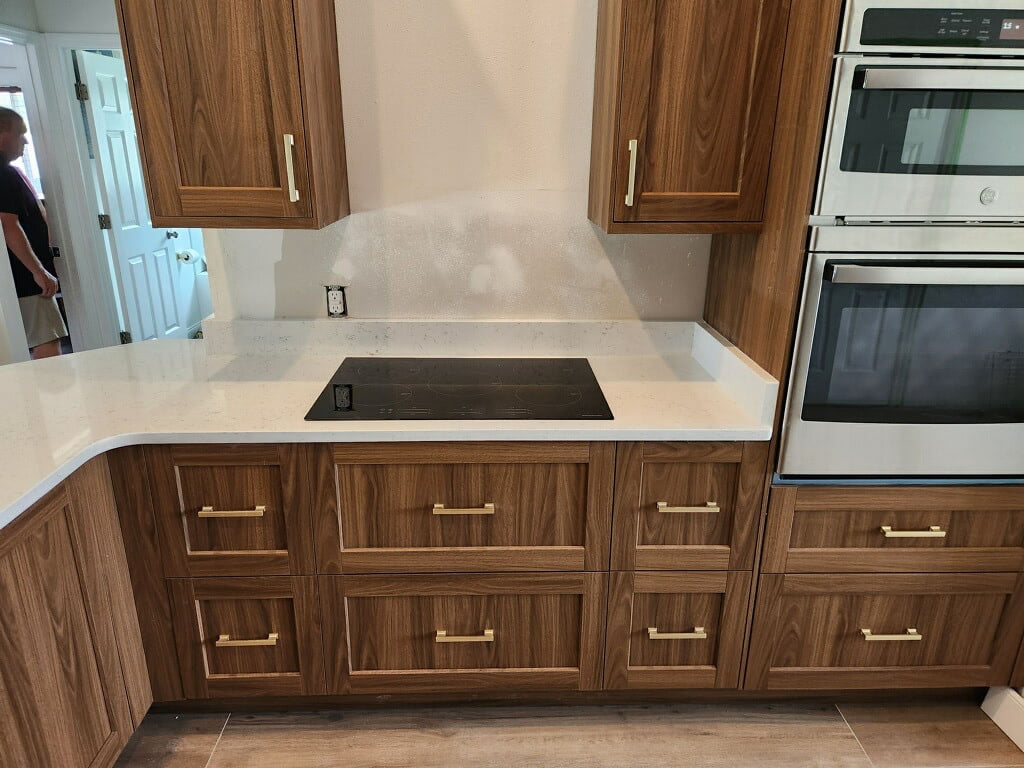
Incorporating Technology in Kitchen Design
Smart Appliances
The integration of smart appliances in kitchen design has revolutionized the way we cook, clean, and manage our kitchens, offering unparalleled convenience and efficiency.
- Smart Refrigerators: Equipped with touch screens, internal cameras, and internet connectivity, smart refrigerators allow you to see inside without opening the door, create shopping lists, and receive notifications about expiration dates. Some models even suggest recipes based on the ingredients available.
- Connected Ovens and Ranges: These appliances can be controlled remotely via smartphone apps, allowing you to preheat the oven, set cooking times, and adjust temperatures from anywhere. Some ovens also feature voice control and integration with virtual assistants like Alexa and Google Assistant.
- Smart Dishwashers: These devices offer features like remote start, cycle monitoring, and maintenance alerts. Advanced models can adjust water usage and cycle times based on the load size and dirt level, ensuring efficient cleaning.
- Automated Coffee Makers: Smart coffee makers can be programmed to brew coffee at a specific time or controlled via an app, ensuring your coffee is ready when you wake up.
Advanced Lighting Solutions
Lighting plays a crucial role in kitchen design, not only for functionality but also for creating the right ambiance. Advanced lighting solutions offer greater control and flexibility.
- LED Lighting: Energy-efficient LED lights can be used under cabinets, inside drawers, and along kickboards to provide task lighting and highlight specific areas. They come in various colors and intensities to suit different needs and preferences.
- Smart Lighting Systems: These systems allow you to control the brightness, color, and timing of your lights through a smartphone app or voice commands. You can create preset lighting scenes for different activities, such as cooking, dining, or entertaining.
- Motion Sensors: Motion-activated lights enhance convenience and safety by automatically turning on when someone enters the kitchen and turning off when the space is unoccupied, reducing energy consumption.
- Dimmer Switches: Installing dimmer switches provides the ability to adjust the lighting levels to create the desired atmosphere, whether it’s bright for cooking or dimmed for a cozy dinner.
Innovative Ventilation Systems
Effective ventilation is essential for maintaining air quality and comfort in the kitchen. Innovative ventilation systems offer improved performance and aesthetic integration.
- Downdraft Ventilation: These systems are integrated into the cooktop or countertop and rise up when needed, drawing smoke and odors down and out of the kitchen. Downdraft vents are ideal for kitchen islands and open-concept designs where traditional overhead hoods might obstruct sightlines.
- Smart Range Hoods: Smart hoods can automatically adjust their fan speed based on the heat and steam generated during cooking. They can be controlled remotely and provide alerts for filter maintenance and replacement.
- Recirculating Ventilation: Advanced recirculating systems use high-efficiency filters to clean the air and remove odors before releasing it back into the kitchen. These systems are suitable for spaces where external venting is not possible.
- Quiet Operation: Modern ventilation systems are designed to operate quietly, ensuring that they do not disrupt conversations or other activities in open-concept kitchens.
Incorporating these technological advancements into kitchen design enhances the functionality, convenience, and overall experience of the space. Smart appliances, advanced lighting solutions, and innovative ventilation systems not only improve efficiency but also contribute to a modern, stylish kitchen that caters to the needs of contemporary living.
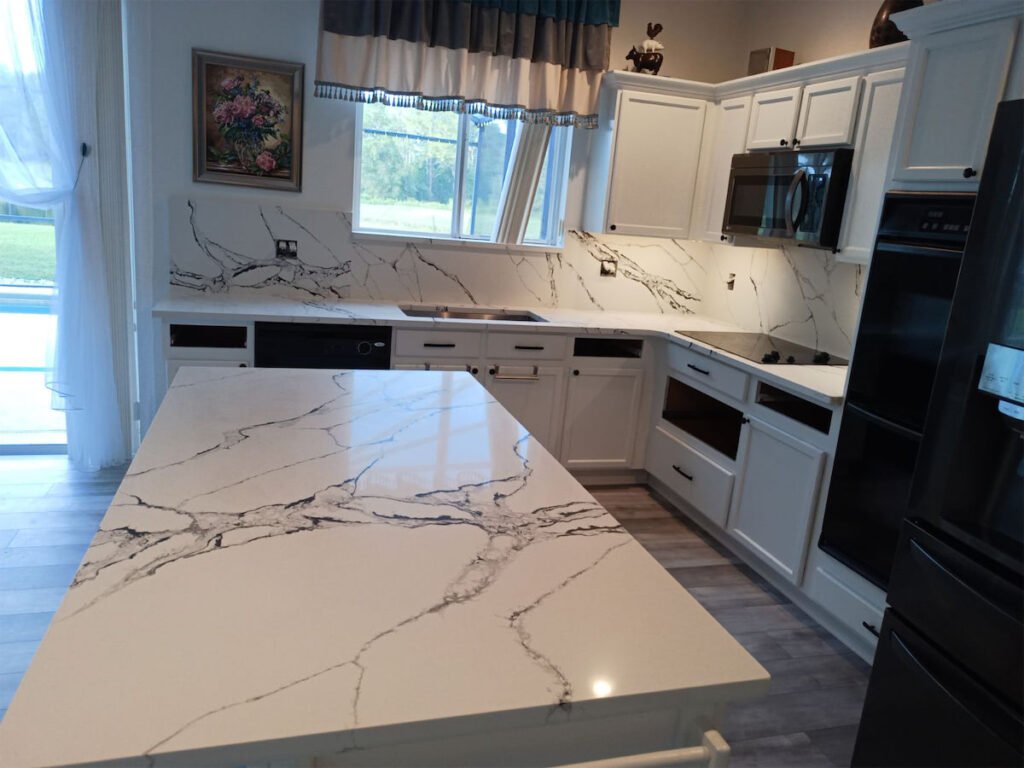
Sustainable Kitchen Design
Eco-friendly Materials
Incorporating eco-friendly materials into kitchen design is a key aspect of creating a sustainable and environmentally responsible space.
- Recycled Countertops: Countertops made from recycled materials, such as glass, paper, or aluminum, offer an environmentally friendly alternative to traditional stone. These materials are durable, attractive, and help reduce waste.
- Bamboo Cabinets: Bamboo is a fast-growing, renewable resource that makes an excellent choice for cabinetry. It is strong, durable, and has a unique aesthetic appeal. Additionally, bamboo’s rapid growth rate ensures a lower environmental impact compared to traditional hardwoods.
- Sustainable Wood: Using certified sustainable wood, such as FSC (Forest Stewardship Council) certified lumber, ensures that the wood is sourced from responsibly managed forests. This helps preserve ecosystems and promotes sustainable forestry practices.
- Low-VOC Paints and Finishes: Volatile organic compounds (VOCs) are harmful chemicals found in many conventional paints and finishes. Opting for low-VOC or VOC-free products improves indoor air quality and reduces environmental impact.
- Recycled Tile: Tiles made from recycled materials, such as ceramic or glass, are an eco-friendly option for backsplashes and flooring. They provide the same durability and aesthetic appeal as traditional tiles while promoting resource conservation.
Energy-efficient Appliances
Energy-efficient appliances are essential for reducing energy consumption and lowering utility bills in a sustainable kitchen.
- ENERGY STAR-rated Appliances: Appliances with the ENERGY STAR label meet strict energy efficiency guidelines set by the U.S. Environmental Protection Agency. These appliances use less energy, helping to reduce greenhouse gas emissions and lower electricity bills.
- Induction Cooktops: Induction cooktops are more energy-efficient than traditional gas or electric stoves because they heat cookware directly using electromagnetic energy. This results in faster cooking times and less wasted heat.
- Efficient Refrigerators: Modern refrigerators with advanced insulation and energy-saving features use significantly less energy than older models. Look for features like inverter compressors, which adjust the cooling intensity based on the contents and usage.
- Energy-efficient Dishwashers: Newer dishwashers use less water and energy while providing superior cleaning performance. Features like soil sensors adjust the cycle length and water usage based on the load, ensuring efficient operation.
Water-saving Fixtures
Water-saving fixtures are crucial for conserving water and reducing the environmental footprint of a kitchen.
- Low-flow Faucets: Low-flow faucets use aerators to reduce water flow without compromising performance. They can significantly decrease water usage, making them an eco-friendly choice for any kitchen.
- Touchless Faucets: Touchless or sensor-activated faucets help reduce water waste by automatically shutting off when not in use. They also promote hygiene by minimizing contact with the faucet handles.
- Water-efficient Dishwashers: Modern dishwashers are designed to use less water while maintaining high cleaning standards. Look for models with water-saving features, such as half-load settings and efficient wash cycles.
- Greywater Systems: Greywater systems collect and treat water from sinks and dishwashers for reuse in irrigation or toilet flushing. Implementing a greywater system can significantly reduce water consumption and promote sustainable water management.
By incorporating eco-friendly materials, energy-efficient appliances, and water-saving fixtures, homeowners can create a sustainable kitchen that not only reduces their environmental impact but also promotes a healthier and more efficient living space. Sustainable kitchen design is an investment in the future, offering long-term benefits for both the planet and the home.
Choosing the Right Stone for Your Kitchen
Assessing Your Needs and Preferences
Selecting the right stone for your kitchen countertops involves a careful assessment of your needs and aesthetic preferences.
- Lifestyle: Consider how you use your kitchen. If you cook frequently and need a surface that can withstand high heat and heavy use, durable stones like granite or quartz may be ideal. If you prefer a more luxurious look and are willing to invest time in maintenance, marble might be a suitable choice.
- Aesthetics: Think about the overall design theme of your kitchen. Do you prefer the classic elegance of marble, the modern look of quartz, or the rustic charm of soapstone? Each stone type offers unique colors, patterns, and finishes that can complement different styles.
- Functionality: Evaluate the functional requirements of your countertops. Stones with higher resistance to stains and scratches, like quartz, are practical for busy kitchens. On the other hand, softer stones like marble can develop a patina over time, which some homeowners find appealing.
Budget Considerations
Your budget plays a significant role in determining the type of stone you choose for your kitchen countertops.
- Cost of Materials: The price of stone countertops varies widely. Granite and quartz are typically mid-range in cost, while marble and exotic stones can be more expensive. It’s important to compare prices and consider the long-term value of your investment.
- Installation Costs: Professional installation is crucial for stone countertops to ensure proper fitting and support. Installation costs can vary based on the complexity of the project and the stone type. Make sure to factor in these costs when planning your budget.
- Long-term Value: While some stones may have a higher upfront cost, their durability and timeless appeal can add significant value to your property. Consider the long-term benefits and potential return on investment when making your decision.
Maintenance Requirements
Different types of stone countertops have varying maintenance needs, which should be considered to ensure the longevity and appearance of your kitchen surfaces.
- Sealing: Natural stones like granite and marble require regular sealing to protect against stains and moisture. Quartz, being non-porous, does not require sealing, making it a low-maintenance option.
- Cleaning: Daily cleaning practices vary by stone type. Mild soap and water are generally recommended, but some stones may require specific cleaners to prevent damage. Avoid harsh chemicals that can etch or discolor the surface.
- Repair and Restoration: Consider the ease of repairing and restoring your chosen stone. Granite and quartz are highly durable and less likely to need repairs, while marble may require periodic polishing and professional restoration to maintain its luster.
- Wear and Tear: Some stones develop a patina over time, which can enhance their character. Marble and soapstone are examples of stones that can develop a unique look with use. If you prefer a countertop that remains unchanged, quartz might be a better choice due to its consistent appearance.
By carefully assessing your needs and preferences, considering your budget, and understanding the maintenance requirements of different stones, you can make an informed decision that will enhance both the functionality and aesthetic appeal of your kitchen. Choosing the right stone is a crucial step in creating a kitchen that meets your practical needs while reflecting your personal style.
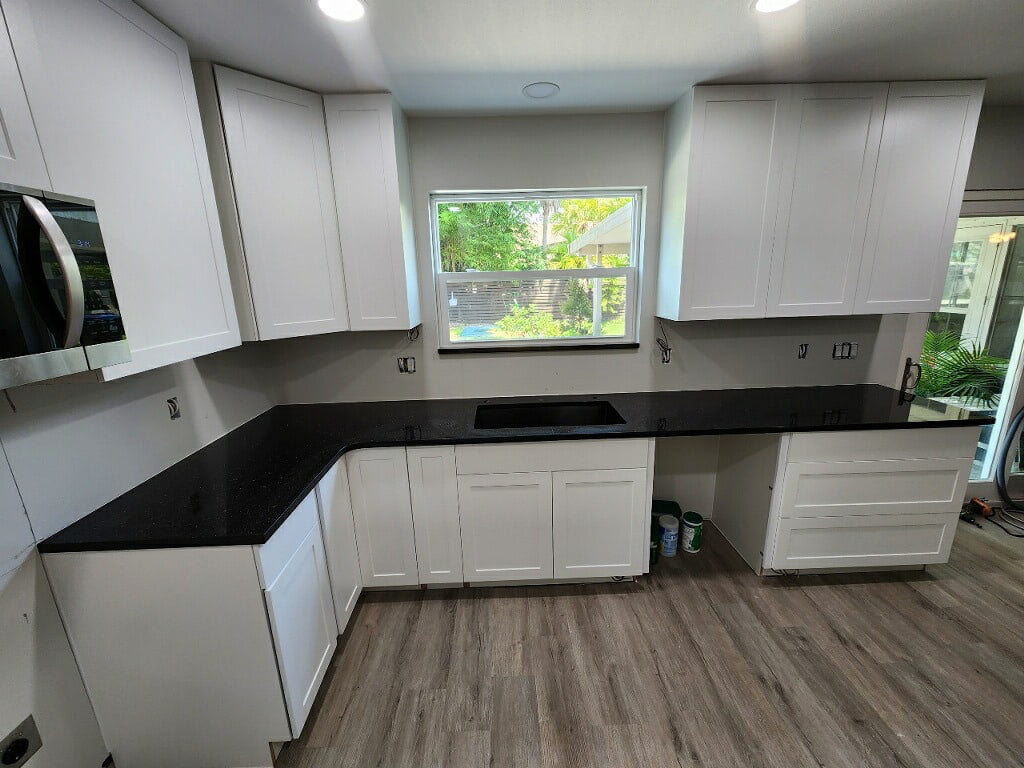
Installation and Maintenance of Custom Stone Countertops
Professional Installation Tips
Proper installation of custom stone countertops is crucial to ensure durability, functionality, and aesthetic appeal. Here are some tips for a successful installation:
- Hire Experienced Professionals: Always opt for a reputable and experienced contractor or stone fabricator. Professional installers have the expertise and tools required to handle stone countertops, ensuring precise cuts and proper fitting.
- Accurate Measurements: Before the installation, take precise measurements of your kitchen to avoid errors. The fabricator will typically visit your home to create a template, ensuring that the countertops fit perfectly.
- Proper Support: Stone countertops are heavy and require adequate support. Ensure that your cabinets are level and reinforced to handle the weight of the stone. Additional supports like brackets or plywood underlayment may be necessary, especially for overhangs and larger sections.
- Seams and Joints: Seam placement is crucial for both aesthetics and structural integrity. A skilled installer will place seams in inconspicuous locations and use color-matched epoxy to create seamless joints. Ensure that the seams are smooth and not prone to collecting dirt or moisture.
- Handling and Transport: Stone slabs should be handled and transported with care to prevent cracks and chips. Ensure that the installers use proper lifting equipment and techniques to avoid damage during installation.
Regular Maintenance Practices
Maintaining your custom stone countertops is essential to preserve their beauty and functionality. Here are some key maintenance practices:
- Cleaning: Use a soft cloth or sponge with mild soap and water for daily cleaning. Avoid abrasive cleaners or pads that can scratch the surface. For deeper cleaning, use stone-specific cleaners recommended by your installer or fabricator.
- Sealing: Natural stones like granite and marble require periodic sealing to protect against stains and moisture. Typically, sealing should be done annually, but frequency may vary based on the stone type and usage. Follow the manufacturer’s instructions for the best results.
- Avoiding Damage: Prevent scratches and etching by using cutting boards and trivets. Avoid placing hot pots and pans directly on the countertop to prevent thermal shock, which can cause cracking. Be cautious with acidic substances like vinegar and citrus, as they can etch stones like marble.
- Spill Management: Wipe up spills immediately to prevent staining, especially on porous stones like marble and granite. Use a blotting technique rather than wiping to avoid spreading the spill.
Dealing with Common Issues
Despite careful maintenance, issues may arise with stone countertops. Here’s how to address some common problems:
- Stains: For stains, use a poultice made from baking soda and water or a commercial stone stain remover. Apply the poultice to the stain, cover it with plastic wrap, and let it sit for 24-48 hours before wiping it off. Repeat if necessary.
- Scratches: Minor scratches can often be buffed out with fine-grit sandpaper or a stone polishing compound. For deeper scratches, professional refinishing may be required.
- Chips and Cracks: Small chips can be repaired with epoxy or resin fillers that match the color of the stone. For larger cracks, it’s best to consult a professional. They can use special adhesives and techniques to restore the integrity and appearance of the countertop.
- Seam Separation: If seams begin to separate or become visible, it may be due to improper installation or settling of the cabinets. A professional can re-adhere and blend the seams using color-matched epoxy.
Proper installation and regular maintenance of custom stone countertops ensure that they remain a beautiful and functional feature in your kitchen for years to come. By addressing common issues promptly and effectively, you can maintain the integrity and appearance of your countertops, making them a lasting investment in your home.
Case Studies and Real-life Examples
Modern Kitchen with Quartz Countertops
Case Study: The Smith Residence
- Overview: The Smith family wanted a sleek, modern kitchen that was both functional and aesthetically pleasing. They opted for quartz countertops to complement their minimalist design.
- Design Elements:
- Color Scheme: The kitchen features a monochromatic palette with white quartz countertops, grey cabinetry, and stainless steel appliances.
- Functionality: The quartz countertops provide a durable, non-porous surface that is resistant to stains and scratches, ideal for the Smiths’ busy lifestyle.
- Integration: The countertops seamlessly integrate with an island that includes a built-in cooktop and under-counter storage, maximizing space and functionality.
- Outcome: The Smiths achieved a contemporary, clean look that is easy to maintain, enhancing both the aesthetic and practical aspects of their kitchen.
Traditional Kitchen with Marble Countertops
Case Study: The Johnson Residence
- Overview: The Johnsons wanted to remodel their kitchen to reflect a classic, timeless elegance. They chose marble countertops to achieve a luxurious and sophisticated look.
- Design Elements:
- Color Scheme: The kitchen features rich, dark wood cabinetry paired with white marble countertops with intricate grey veining, creating a striking contrast.
- Functionality: While marble requires more maintenance, the Johnsons were willing to invest the time for its unparalleled beauty. They use cutting boards and trivets to protect the surface.
- Integration: The countertops are complemented by a marble backsplash, providing continuity and enhancing the overall design.
- Outcome: The Johnsons’ kitchen exudes elegance and charm, with marble countertops that serve as the centerpiece of their traditional design.
Rustic Kitchen with Soapstone Countertops
Case Study: The Williams Residence
- Overview: The Williams family aimed to create a warm, rustic kitchen that reflects their love for natural materials. Soapstone countertops were chosen for their unique texture and natural beauty.
- Design Elements:
- Color Scheme: The kitchen features reclaimed wood cabinetry and soapstone countertops with natural, muted grey tones that age gracefully over time.
- Functionality: Soapstone is heat resistant and relatively low maintenance, requiring only occasional oiling to enhance its patina. This fits well with the Williams’ casual and functional kitchen use.
- Integration: The countertops include a built-in farmhouse sink, further enhancing the rustic charm and providing practical benefits.
- Outcome: The Williams’ kitchen is a cozy, inviting space that blends functionality with rustic aesthetics, with soapstone countertops adding character and warmth.
Summary
These case studies illustrate how different types of custom stone countertops can be tailored to suit various design preferences and lifestyles:
- Modern Kitchens: Quartz countertops offer durability and a sleek appearance, perfect for contemporary designs.
- Traditional Kitchens: Marble countertops provide timeless elegance and sophistication, ideal for classic styles.
- Rustic Kitchens: Soapstone countertops add natural beauty and a sense of warmth, fitting seamlessly into rustic settings.
By understanding the unique benefits and aesthetic qualities of each stone type, homeowners can choose the perfect countertop material to enhance their kitchen’s design and functionality.
Expert Tips for Designing Your Dream Kitchen
Collaborating with Designers and Architects
Working with professional designers and architects can significantly enhance the outcome of your kitchen design project. Here are some tips to ensure a successful collaboration:
- Communicate Your Vision: Clearly articulate your ideas, preferences, and requirements to your designer or architect. Share inspiration photos, sketches, and any specific features you want to include in your kitchen.
- Set Realistic Expectations: Be open about your budget, timeline, and any constraints. This helps the professionals create a feasible plan that meets your needs while staying within your limitations.
- Leverage Their Expertise: Trust their knowledge and experience. Professionals can offer valuable insights into the latest trends, materials, and technologies that can enhance your kitchen’s design and functionality.
- Regular Updates: Schedule regular meetings to review progress, discuss any changes, and address concerns. Open communication ensures that the project stays on track and any issues are resolved promptly.
- Review Plans Thoroughly: Before finalizing designs, review all plans and blueprints in detail. Make sure you understand the layout, dimensions, and placement of key elements to avoid surprises during construction.
Personalizing Your Space
Personalizing your kitchen ensures that it reflects your style and meets your specific needs. Consider these tips to make your kitchen uniquely yours:
- Custom Cabinetry: Opt for custom or semi-custom cabinetry to tailor storage solutions to your requirements. Choose finishes, colors, and hardware that align with your personal style.
- Unique Countertops: Select countertops that not only look beautiful but also suit your lifestyle. Whether you prefer the elegance of marble, the durability of quartz, or the rustic charm of soapstone, the right countertop can make a significant impact.
- Backsplash and Tile Choices: Use backsplash tiles to add color, texture, and personality to your kitchen. Consider patterns, materials, and designs that complement your overall aesthetic.
- Lighting Fixtures: Choose lighting that enhances the ambiance and functionality of your kitchen. Pendant lights over an island, under-cabinet lighting, and statement fixtures can all contribute to a personalized look.
- Decorative Elements: Incorporate decorative elements such as artwork, plants, and unique accessories. Open shelving can be a great way to display personal items and add character to the space.
Staying Within Budget
Designing a dream kitchen can be costly, but careful planning and smart choices can help you stay within budget without compromising on quality or style.
- Prioritize Needs vs. Wants: Identify the essential elements that are non-negotiable and separate them from the items that are nice to have. Focus on investing in high-priority areas first.
- Set a Realistic Budget: Determine a budget that covers all aspects of the project, including materials, labor, and unexpected expenses. Stick to this budget to avoid financial strain.
- Compare Costs: Get multiple quotes for materials, appliances, and labor to ensure you are getting the best value for your money. Don’t hesitate to negotiate prices where possible.
- Opt for Cost-effective Materials: Look for materials that offer a good balance between cost and quality. For example, consider laminate or butcher block countertops as budget-friendly alternatives to more expensive options.
- DIY Where Possible: If you have the skills, consider taking on some of the smaller tasks yourself, such as painting, installing hardware, or assembling cabinetry. This can save labor costs and give you a sense of accomplishment.
- Plan for the Future: Consider the long-term costs and benefits of your choices. Investing in energy-efficient appliances and durable materials can save money on utility bills and maintenance over time.
By collaborating effectively with professionals, personalizing your space, and staying mindful of your budget, you can design a kitchen that is both beautiful and functional, tailored to your needs and preferences.
Conclusion
Recap of Key Points
Throughout this article, we’ve explored various aspects of innovative kitchen designs with a focus on custom stone countertops. Here’s a summary of the key points covered:
- Introduction: Highlighted the importance of innovative kitchen designs and the role of custom stone countertops in enhancing both functionality and aesthetics.
- The Evolution of Kitchen Design: Traced the historical developments and modern trends in kitchen design, emphasizing the transition from functional to multifunctional and stylish spaces.
- Types of Custom Stone Countertops: Discussed the characteristics, benefits, and aesthetic appeal of different stones, including granite, marble, quartz, soapstone, and other exotic stones.
- Benefits of Custom Stone Countertops: Explored the durability, aesthetic appeal, value addition to property, and customization options provided by custom stone countertops.
- Innovative Design Ideas: Introduced concepts like open concept kitchens, multi-functional islands, integrated appliances, and creative storage solutions to maximize efficiency and design.
- Incorporating Technology in Kitchen Design: Examined how smart appliances, advanced lighting solutions, and innovative ventilation systems enhance the modern kitchen experience.
- Sustainable Kitchen Design: Highlighted the use of eco-friendly materials, energy-efficient appliances, and water-saving fixtures to create a sustainable and environmentally friendly kitchen.
- Choosing the Right Stone for Your Kitchen: Provided guidance on assessing needs, considering budget, and understanding maintenance requirements to select the ideal stone for your kitchen.
- Installation and Maintenance of Custom Stone Countertops: Offered professional installation tips, regular maintenance practices, and solutions for common issues to ensure the longevity and beauty of stone countertops.
- Case Studies and Real-life Examples: Presented real-life examples of modern, traditional, and rustic kitchens, showcasing the versatility and impact of different stone countertops.
- Expert Tips for Designing Your Dream Kitchen: Shared advice on collaborating with designers, personalizing your space, and staying within budget to create a kitchen that meets your needs and reflects your style.
Final Thoughts on Innovative Kitchen Designs
Innovative kitchen designs are all about blending functionality, aesthetics, and technology to create a space that is not only practical but also visually stunning. Custom stone countertops play a pivotal role in this transformation, offering unique benefits such as durability, beauty, and value addition. Whether you’re opting for the timeless elegance of marble, the modern appeal of quartz, or the rustic charm of soapstone, choosing the right stone is crucial to achieving your dream kitchen.
By embracing new trends, incorporating smart technologies, and prioritizing sustainability, you can design a kitchen that meets the demands of contemporary living while reflecting your personal style. Collaboration with professionals, thoughtful planning, and a clear understanding of your needs and budget are key to successfully realizing your vision.
In the end, an innovative kitchen is more than just a place to cook; it’s a central hub for family life, social gatherings, and personal expression. With the right design choices and materials, your kitchen can become a beautiful, efficient, and inspiring space that enhances your home and lifestyle.

